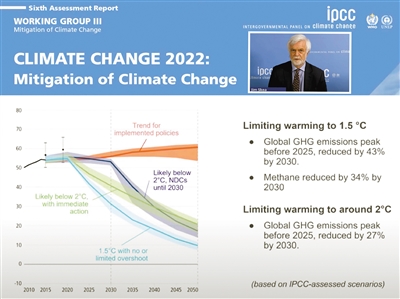
 |
| Jim Skea, co-chair of the working group behind the IPCC report, speaking at the press conference on April 4 GMT. (PHOTO: SCREENSHOT FROM IPCC) |
According to the report released by the Intergovernmental Panel on Climate Change (IPCC) on April 4, greenhouse gas emissions must peak by 2025, and need to be nearly halved this decade. This is the last chance for the world to limit future heating to 1.5℃ above pre-industrial levels.
Voices from scientists
The world can still hope to stave off the worst ravages of climate breakdown, but only through a "now or never" push to a low-carbon economy and society. The world's leading climate scientists have in effect given a final warning to governments on the climate.
With the world failing to make the changes needed in the past, temperatures are predicted to soar by more than 3℃ with catastrophic consequences, unless policies and actions are urgently strengthened.
Jim Skea, professor at the Imperial College London, said, "It's now or never, if we want to limit global warming to 1.5℃. Without immediate and deep emissions reductions across all sectors, it will be impossible."
Pete Smith, a professor of soils and global change at Aberdeen University, said, "The time of reckoning is now. We have one decade to get on track. We use fossil fuels in all these things that we need to change."
Meanwhile, less developed countries warned they were ill-equipped to make the changes needed. They require financial assistance from richer nations to cut emissions and help them adapt to the impact of the climate crisis.
Madeleine Diouf Sarr, the chair of the least developed countries group at the UN climate talks, said, "There can be no new fossil fuel infrastructure. The emissions from existing and planned infrastructure alone are higher than scenarios consistent with limiting warming to 1.5℃, with no or limited overshoot. We cannot afford to lock in the use of fossil fuels."
Ways to save our planet
Accordingly, UN scientists laid out a plan that they believe could help people avoid the worst impacts of rising temperatures.
In their view, to avoid very dangerous warming, carbon emissions need to peak within three years, and fall rapidly after that. Even then, technology to pull CO_2 from the air will still be needed to keep temperatures down.
One key component of reducing emissions is to limit demand, which the IPCC has divided into three types of change. First, "Socio-cultural factors" are behavioral choices individuals make. Second, "Infrastructure use" refers to changes in the design of infrastructure that makes it possible for individuals to make different choices. Third, "End-use technology adoption" refers to changes in the uptake of technologies by end users.
"Having the right policies, infrastructure and technology in place to enable changes to our lifestyles and behavior can result in a 40-70 percent reduction in greenhouse gas emissions by 2050. This offers significant untapped potential," said IPCC Working Group III Co-Chair Priyadarshi Shukla, in a written statement, adding that, "The evidence also shows that these lifestyle changes can improve our health and well-being."
The immediate goal is to accelerate those efforts and ramp up climate finance to ensure that it's a truly global effort, said Nathaniel Keohane, president of the Center For Climate and Energy Solutions in Virginia, and a White House adviser for former U.S. president Barack Obama.
In the longer term, governments need to invest in research and development activities to explore the feasibility of carbon-removal technologies that could help to bend the curve in decades to come. "It's a Herculean effort, and so we better get started," said Keohane.
Powering China's net-zero energy goal
As a member of the international community, China proposed its emission reduction target by 2060, and energy researchers are helping China achieve this goal. Research teams at Chinese universities and research institutes presented their solutions in Nature magazine.
Baoshan Zhu, a hydraulic engineer at Tsinghua University, believed that development of storing clean energy technology is very important. Pumped hydro-power is the most common type of energy storage in use globally, often supporting electricity grids that rely on solar or wind power.
Additionally, new energy technologies, such as harnessing offshore green energy and turning air into electricity, are being studied by researchers at Tsinghua University and Institutes at the Chinese Academy of Sciences.
As demand for wind and solar power increases, systems for accurately forecasting their availability are becoming more important to power companies in China, said Fei Wang, a researcher at North China Electric Power University, adding that it is indispensable to forecast future needs.


 Next
Next




